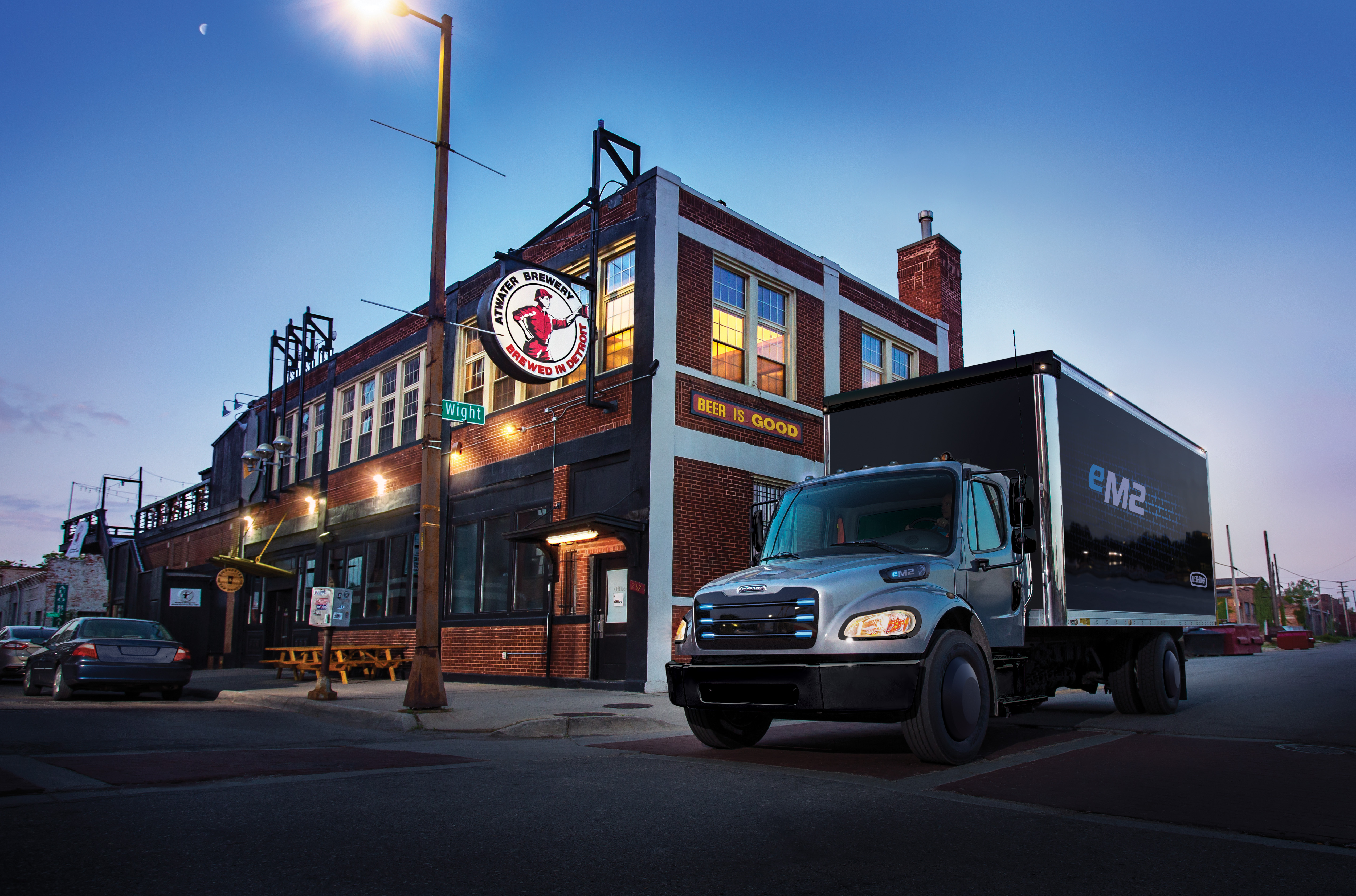Daimler rolls out electric trucks for North America

PORTLAND, Ore. – Daimler Trucks North America has unveiled electric Class 8 and medium-duty trucks today, with plans to have a 30-truck “innovation fleet” working in selected applications before the end of the year.
“It is our target at Daimler to have the broadest – the absolute broadest – e-truck fleet in North America by 2021,” said president and CEO Roger Nielsen, as an electrified version of the Class 8 Cascadia rolled by. An electric version of the eM2 106 medium-duty vehicle quietly followed right after.
“Heavy-duty electric vehicles present the greatest engineering challenges, but they also present the greatest learning opportunities,” he said.
The eCascadia features up to 730 peak horsepower, with batteries that offer 550 kwh, and a range of up to 400 km. Up to 80% of the battery power can be renewed in about 90 minutes of charging, offering another 300 km of range. It’s primarily being designed for port drayage trucks and short-haul applications.
For the medium-duty segment, the eM2 offers 480 peak horsepower, drawing on batteries with 325 kwh of capacity and a 375-km range. Recharging of those batteries by 80% can be completed in about 60 minutes, offering another 300 km of range. That truck is being designed for local distribution, pickup and delivery, food and beverage applications, and last-mile deliveries.
“It’s easy to find use cases for the eM2 today,” Nielsen said. “We expect high customer demand for this truck when we make it available for series production sometime in the next two to three years.”

The medium-duty eM2 will take advantage of the stop-and-go activity in urban environments, he added, referring to regenerative braking.
The eCascadia has an 80,000-lb. gross combination weight rating, while the eM2 comes in at 26,000 lb.
While high-profile launches for North America, these are hardly the first electrified trucks to emerge from the Daimler portfolio.
The MercedesBenz eActros has a 200-km range and a 55,000-lb. gross combination weight rating and is being tested with customers in Europe. The E-Fuso Vision One Class 8 truck being tested in Japan has a range of 350 km and gross combination weight rating of 51,000 lb. At the smaller end of the scale, the Class 4 Fuso eCanter – unveiled last year in Atlanta — is available in series production.
The fully electric Mercedes-Benz Citaro goes into series production in late 2018, while the Mercedes-Benz eActros distribution trucks unveiled earlier this year will be working with the first customers by the second half of 2018.
Freight is not the only focus, of course. Thomas Built Buses now has an all-electric Saf-T-Liner C2 Jouley school bus, unveiled in November 2017, which offers a 160-km range and begins limited production in 2019.
“A school bus is the most viable use,” Nielsen said of electrified vehicles, referring to its predictable routes and time available for recharging. The early applications are also offering new insights into troubleshooting electric vehicles, he added. “We’re learning about parasitic losses. It takes a lot of energy heating and cooling.” The buses also come in seven different wheelbase configurations, giving engineers a chance to explore different ways to package the batteries.
Freightliner Custom Chassis Corp., meanwhile, built more than 100 electric vehicles in 2012 with Electric Vehicles International on the MT-55 walk-in van chassis.
The batteries for the newest trucks are shared by the eCetaro and eCascadia, while the battery management systems can be found in the Actros. The goal is to develop a single unified, proprietary electric powertrain for all the vehicles.
The announcements come as Daimler unveils a new global E-Mobility Group that will combine the company’s “global scale, global presence, and a strong backbone of support,” said Martin Daum, member of the Daimler Board of Management for trucks and buses. It will be led by Gesa Reimelt, currently the head of product projects powertrain and eDrive Mercedes-Benz passenger cars. “Even an eTruck needs steering and braking,” he said, referring to the wide array of engineering resources that are required beyond the batteries alone.
A key challenge that remains, meanwhile, is where such electrified vehicles will recharge. “We are focusing our efforts on quickly advancing that development,” Nielsen said. “We are all in for tackling electrification challenges for North America.”
Daimler AG is a founding member of the CharIN Charging Interface Initiative, which is looking to develop a standard charging system for battery-powered vehicles. This work is being completed alongside utilities and service providers.
“Without an infrastructure to support and charge these vehicles, there will be no eTrucks on the road,” Nielsen said. “We have the responsibility to give our customers support on the infrastructure side.” For terminals and ports, that means consulting services.
There are other key questions to be answered along the way. “How can we improve the range? How can we improve the payload? How can we improve the energy consumption,” Nielsen says. No announcement was made about current payload capacities. “We have much to learn, but we are well on our way.”
Daum describes it as an “evolutionary, not a revolutionary” process.
But expect more electrification rather than hybridization from Daimler.
“I’m not a big fan of hybrid,” Daum said. “For me, a hybrid gives you the worst of both worlds.” Such vehicles still include the challenges of emissions systems for combustion engines and the new technologies needed for electrification. “It’s good for the feeling but not much else.”
“It’s an exciting moment to be here,” Daum said.
Have your say
This is a moderated forum. Comments will no longer be published unless they are accompanied by a first and last name and a verifiable email address. (Today's Trucking will not publish or share the email address.) Profane language and content deemed to be libelous, racist, or threatening in nature will not be published under any circumstances.